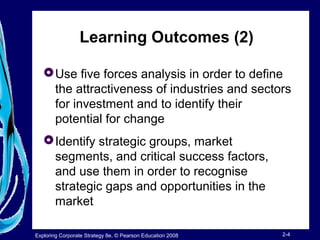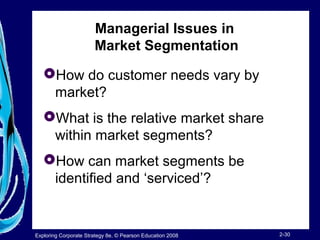Chapter02
- 1. The Focus of Part 1: The Strategic Position How to analyse an organisation’s position in the external environment How to analyse the determinants of strategic capability How to understand an organisation’s purposes, taking into account corporate governance, stakeholder expects and business ethics How to address the role of history and culture in determining an organisation’s position Exploring Corporate Strategy 8e, © Pearson Education 2008 2-1
- 2. The Strategic Position 2: The Environment
- 3. Learning Outcomes (1) Analyse the broad macro-environment of organisations in terms of political, economic, social, technological, environmental and legal factors Identify key drivers in this macro-environment and use these key drivers to construct alternative scenarios with regard to environmental change Exploring Corporate Strategy 8e, © Pearson Education 2008 2-3
- 4. Learning Outcomes (2) Use five forces analysis in order to define the attractiveness of industries and sectors for investment and to identify their potential for change Identify strategic groups, market segments, and critical success factors, and use them in order to recognise strategic gaps and opportunities in the market Exploring Corporate Strategy 8e, © Pearson Education 2008 2-4
- 5. Exhibit 2.1 Layers of the business environment The Organisation Exploring Corporate Strategy 8e, © Pearson Education 2008 2-5
- 6. The Macro-Environment PESTEL Scenarios Key drivers Exploring Corporate Strategy 8e, © Pearson Education 2008 2-6
- 7. PESTEL Framework Political Economic Technological Social Environmental Legal Exploring Corporate Strategy 8e, © Pearson Education 2008 2-7
- 8. The PESTEL Framework Exploring Corporate Strategy 8e, © Pearson Education 2008 2-8
- 9. What Are Key Drivers for Change? Key drivers for change are environmental factors that are likely to have a high impact on the success or failure of strategy. Exploring Corporate Strategy 8e, © Pearson Education 2008 2-9
- 10. What is a Scenario? Scenarios are detailed and plausible views of how the business environment of an organisation might develop in the future based on key drivers for change about which there is a high level of uncertainty. Exploring Corporate Strategy 8e, © Pearson Education 2008 2-10
- 11. Industries and Sectors Competitive forces Competitive cycles Industry life cycle Exploring Corporate Strategy 8e, © Pearson Education 2008 2-11
- 12. Exhibit 2.2 The Five Forces Framework Potential entrants Competitive rivalry Buyers Substitutes Suppliers Exploring Corporate Strategy 8e, © Pearson Education 2008 2-12
- 13. The Threat of Entry: Barriers to Entry Scale and experience Access to supply and distribution channels Expected retaliation Legislation or government action Differentiation Exploring Corporate Strategy 8e, © Pearson Education 2008 2-13
- 14. Why Are Substitutes a Threat? Substitutes can reduce demand for a particular class of products as customers switch to alternatives. • Price/performance ratio • Extra-industry effects Exploring Corporate Strategy 8e, © Pearson Education 2008 2-14
- 15. The Power of Buyers Are buyers concentrated? What are the costs of switching? Does backward vertical integration exist? Exploring Corporate Strategy 8e, © Pearson Education 2008 2-15
- 16. The Power of Suppliers Are suppliers concentrated? What are the costs of switching? Does forward vertical integration exist? Exploring Corporate Strategy 8e, © Pearson Education 2008 2-16
- 17. Degree of Competitive Rivalry Competitor balance Industry growth rate High fixed costs High exit barriers Low differentiation Exploring Corporate Strategy 8e, © Pearson Education 2008 2-17
- 18. Managerial Implications Which industries should we enter or leave? What influence can we exert? How are competitors differently affected? Exploring Corporate Strategy 8e, © Pearson Education 2008 2-18
- 19. Other Issues in a Five Forces Analysis Define the ‘right’ industry Determine whether industries are converging Identify complementary products Exploring Corporate Strategy 8e, © Pearson Education 2008 2-19
- 20. Exhibit 2.3 The Industry Life Cycle Exploring Corporate Strategy 8e, © Pearson Education 2008 2-20
- 21. Exhibit 2.4 Cycles of Competition Exploring Corporate Strategy 8e, © Pearson Education 2008 2-21
- 22. What is Hypercompetition? Hypercompetition occurs where the frequency, boldness and aggressiveness of dynamic movements by competitors accelerate to create a condition of constant disequilibrium and change. Exploring Corporate Strategy 8e, © Pearson Education 2008 2-22
- 23. Exhibit 2.5 Comparative Industry Structure Analysis Exploring Corporate Strategy 8e, © Pearson Education 2008 2-23
- 24. Competitors and Markets Strategic groups Strategic customers Market segments Exploring Corporate Strategy 8e, © Pearson Education 2008 2-24
- 25. What are Strategic Groups? Strategic groups are organisations within an industry with similar strategic characteristics, following similar strategies or competing on similar bases. Exploring Corporate Strategy 8e, © Pearson Education 2008 2-25
- 26. Characteristics for Identifying Strategic Groups Scope of activities Extent of product diversity Extent of geographic coverage Number of segments served Distribution channels Resource commitment Extent of branding Marketing effort Extent of vertical integration Product quality Technological leadership Organisational size Exploring Corporate Strategy 8e, © Pearson Education 2008 2-26
- 27. Benefits of Identifying Strategic Groups Understanding competition Analysis of strategic opportunities Analysis of mobility barriers Exploring Corporate Strategy 8e, © Pearson Education 2008 2-27
- 28. What is a Market Segment? A market segment is a group of customers who have similar needs that are different from customer needs in other parts of the market. Exploring Corporate Strategy 8e, © Pearson Education 2008 2-28
- 29. Exhibit 2.7 Some Bases of Market Segmentation Exploring Corporate Strategy 8e, © Pearson Education 2008 2-29
- 30. Managerial Issues in Market Segmentation How do customer needs vary by market? What is the relative market share within market segments? How can market segments be identified and ‘serviced’? Exploring Corporate Strategy 8e, © Pearson Education 2008 2-30
- 31. What is a Strategic Customer? A strategic customer is the person(s) at whom the strategy is primarily addressed because they have the most influence over which goods or services are purchased. Exploring Corporate Strategy 8e, © Pearson Education 2008 2-31
- 32. What are Critical Success Factors? Critical success factors (CSFs) are those product features with which a organisation must outperform the competition because they are particularly valued by a group of customers. Exploring Corporate Strategy 8e, © Pearson Education 2008 2-32
- 33. Types of Opportunity In substitute industries In other strategic groups In targeting buyers For complementary products In new market segments Over time Exploring Corporate Strategy 8e, © Pearson Education 2008 2-33
- 34. Case Example: The European Brewing Industry Complete a PESTEL analysis of the European brewing industry. Complete a five forces analysis for the industry. Exploring Corporate Strategy 8e, © Pearson Education 2008 2-34
Editor's Notes
- Insert Video 1 (Kevan Scholes), Section 2 (PESTEL) from 1:20-2:20
- Insert clip from Video 2 (Richard Whittington) section on five forces and industry attractiveness beginning at 1:51-3:02 (if a longer clip is desired; begin at 1:23).


































